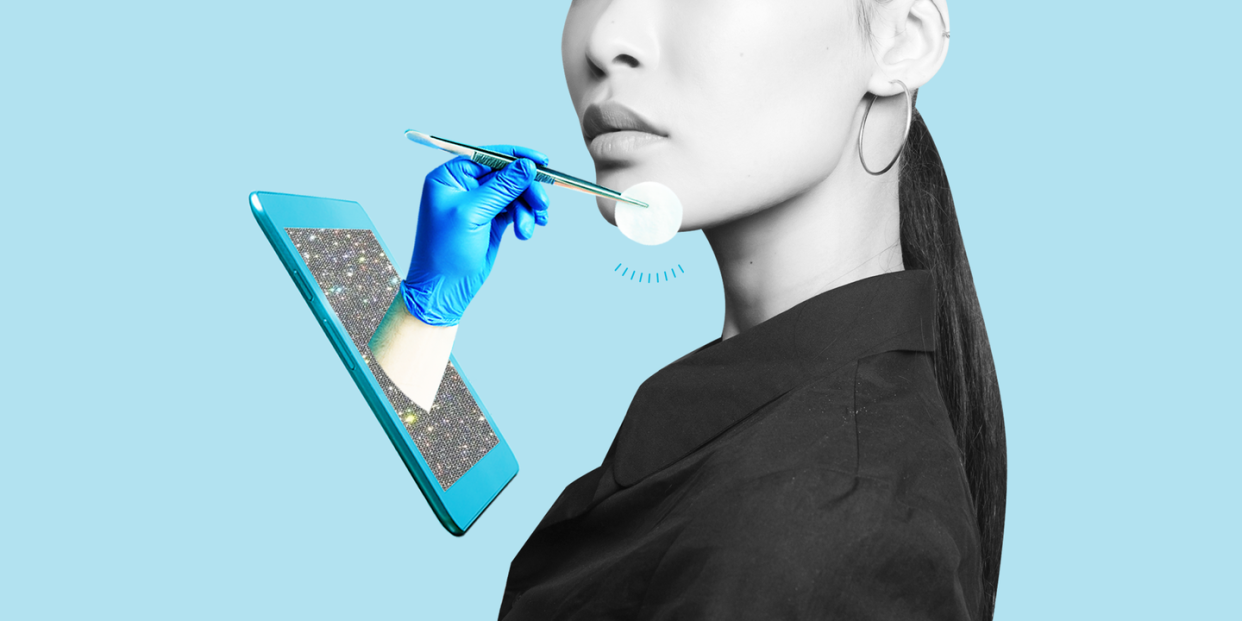I Tried a Virtual Derm Appointment and I’ll Never Go In-Office Again

Listen, even though I’m a grown-ass adult—and, ahem, a beauty editor—I hate going to the dermatologist. Sure, getting to geek out with my derm about my acne or eczema is pretty fun, and yes, I’m incredibly privileged to even have the access (and health insurance) to go to the derm, but between needing to schedule the appointment way in advance (like, my-breakout-will-probs-be-gone-by-then advance), sneaking out of work early to get to the appointment, and then forgetting every single question I had by the time I’m finally in the exam room, the whole ordeal can feel…exhausting.
So when a handful of New York City–based derms began canceling their IRL appointments in light of COVID-19, I was super intrigued by their new alternative: virtual dermatology appointments (aka teledermatology). Like, would hopping on a video call really be just as effective as being there in person? And if so, why on earth would I ever go to the office again?
And because I am a ~journalist~ and also have nothing better to do, I booked an appointment with dermatologist Morgan Rabach, MD, cofounder of LM Medical NYC, to get the full experience for myself.
Teledermatology 101

Prior to my appointment, Dr. Rabach’s office emailed me the intake forms and sent me a link where I’d “check in” (virtually, obvs) at our allotted time. I signed on right at 2 p.m., expecting the usual wait that comes with any medical appointment, but was greeted by Dr. Rabach immediately. Damn.
And unlike that weird, kiiinda awkward vibe of seeing a teacher or coworker outside of school or the office, I actually felt super comfortable (and a little relieved) as we started chatting. Because even though these virtual appointments are new to me, they aren’t to physicians—dermatologists have actually been using them for years, even if they’ve only recently become popular.
“Teledermatology has been around for a really long time, especially in parts of the country where dermatologists are far away or booked up and patients need a quick fix,” says Dr. Rabach. “It definitely doesn’t replace an in-office visit, but when you can’t get to a doctor—especially in conditions like this—it’s actually a really, really helpful tool.”
What you can (and can’t) expect
Lately, Dr. Rabach’s patients have booked appointments for everything from regular skin checks to mysterious rashes, although acne and breakouts are definitely some of the more consistent reasons. “A lot of people have been experiencing breakouts, whether they’ve changed their routine or diet, they’re touching their face more, or they’re feeling some level of stress,” she says.
There are definitely some limitations to video consultations—the most obvious one being a lack of touch, which is essential for things like skin cancer screenings—but Dr. Rabach says plenty of open dialogue (she asks tons of questions about her patient’s symptoms to get an accurate sense of what they’re dealing with) and a little preparation on the patient’s end can help make a telederm session really successful.
The appointment

One of the easiest ways to make sure you’re getting the most out of a telederm appointment is by providing your doctor with plenty of photos. Yes, you’ll be video-chatting during your appointment, but if you’re dealing with something like an eczema flare-up, you’ll want to take photos as soon as you notice symptoms because your skin may calm down by the time of your appointment.
You’ll also want to write down any questions you’d like to go over with your derm, take notes while you’re chatting, and bring a list of all the skincare products you’re currently using (some derms will even walk through your routine with you, so it’s not a bad idea to have your products nearby to check ingredients).
Prior to my appointment with Dr. Rabach, I made a list of my skin concerns (mainly a little discoloration and dryness) and wrote down a couple of Qs about my current routine (Should I start washing my face in the morning? Am I exfoliating too frequently?) so I wouldn’t get sidetracked. Since I wasn’t showing her a specific breakout or rash—my skin has just been fairly blah lately—we ended up having a long convo about everything from exfoliation to cleansers (for the record, Dr. Rabach is a fan of cleansing twice a day and suggested I swap in a gentle face wash in the a.m. to help cut down on excess oil and dead skin cells).
The results
TBH, there wasn’t anything I didn’t love about my first telederm appointment. As someone who really values my derm’s insight, I was super happy with how relaxed our session was—there was no sense of Dr. Rabach rushing to get to another patient or meeting, and I really felt like I had her full attention. As long as you show up to your appointment prepared, you can get so much out of your session—maybe even more than an in-office appointment.
But like Dr. Rabach says, teledermatology isn’t an effective alternative for every situation, especially in-office appointments that require physical touch—like screenings or treatments. Still, they’re an excellent option for treating more identifiable issues when you’re unable to meet IRL, like acne, bumps, and rashes. FWIW, I know I’ll be booking my next appointment virtually, even after the world stops burning.
You Might Also Like

